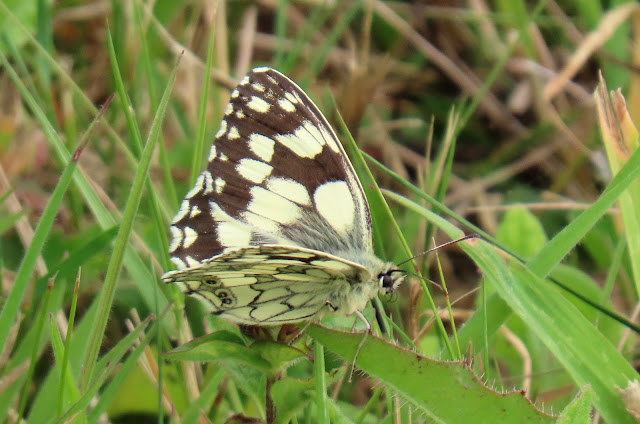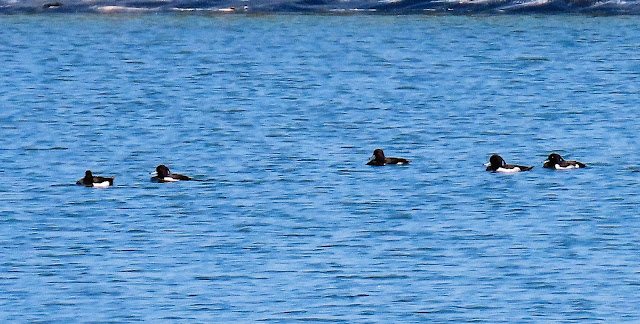Thursday, 3rd July: Back to warm and sunny weather, with plenty of sunshine, some high white cloud and a light to moderate SW breeze.
Bilsham farm: With the prolonged dry conditions I decided to visit three sites locally where there was at least some fresh water still remaining. First up was the farm reservoir here, but it proved to be quite disappointing today....
There were just three Tufted Ducks and five Mallards, (including a female with a brood of fairly small young), four Little Grebes and 22 Coots on the water, plus a few of the commoner gulls. Four House Martins and five Swallows were feeding above for a while, whilst the surrounding hedgerows held a singing Yellowhammer, a Blackcap and a family of Whitethroats, with one of the latter singing almost continuously, but that was about it, except for two noisy Jays making their presence felt.
Shripney area: On my way to two small and adjacent farm reservoirs, the hedgerows held a singing Yellowhammer, ten Goldfinches, four Greenfinches which seemed to be a family group, four Linnets (a pair and two juveniles), a Chiffchaff, two Blackcaps, two Whitethroats and a Reed Warbler carrying food to its nearby nest in a patch of reeds. A pair of Buzzards was also noted in the area.
On reaching the reservoirs, the larger one held just a single Little Grebe and two female Mallards - one with a brood of six well-grown young and the second with a brood of six much younger and smaller ducklings. Three Swifts and a couple of Swallows were also feeding above the water here for some while. The smaller reservoir held five Coots and a surprise pair of Little Grebes with small young.
Scanning the recently cropped arable fields behind the reservoirs, a large falcon resting on the ground turned out to be a Peregrine, probably a young bird.
Moving on to the Lidsey WTW area I was pleased to catch up with a wader at last when a Common Sandpiper was located. On the water here were three Little Grebes, a Mallard with a brood of small young and seven Tufted Ducks. A pair of Greenfinches were active and six Swallows were feeding over the water.
Tuesday, 1st July: A very warm day right from the outset, with prolonged sunshine and some high white cloud, but feeling quite muggy in just a light SW breeze, before the wind brought some relief as it gradually increased to force 4 along the coast.
Elmer Rocks: A predictably quiet morning for birding in the calm and very warm (hot!) conditions. There was little to report, with hardly any Mediterranean Gulls about now, perhaps just three or four in a large mixed flock of gulls moving about offshore, whilst a total of six Sandwich Terns were fishing and moving back and forth. Four Little Egrets and a Grey Heron were also feeding along the shoreline on the low tide, before too many walkers and beach-goers were around.
A circuit of the fields behind the beach found at least three Blackcaps present and singing quite frequently, plus two Whitethroats and a Chiffchaff, whilst high up and at distance were at least four Swifts and a Buzzard. Around Poole Place there four Linnets, a couple of Greenfinches, around ten Goldfinches, a Chaffinch, two Green Woodpeckers and four Stock Doves.
























































